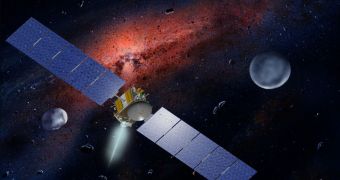This weekend, NASA will launch a new mission, the Dawn spacecraft, which will venture into the asteroid belt to rendez-vous with two of the largest asteroids in the solar system, Ceres and Vesta. The asteroid belt, located between Mars and Jupiter, is the largest concentration of asteroids in the solar system, where 98.5% of asteroid orbits can be found.
Ceres is the largest asteroid about the size of Texas, recently classified as the smallest of the three dawn planets, according to the latest classification of planets, which degraded Pluto from the planet status to the one of dwarf planet.
Vesta is the second most massive object in the asteroid belt, irregularly shaped and around the size of Arizona, with an estimated mass of nearly 9% the one of the entire asteroid belt and a huge crater occupying 80 of the entire surface of the asteroid.
This is the first one the Dawn mission will encounter in its voyage, in approximately four years. Then, in 2015, it is set to rendez-vous Ceres, in what will be a spectacular comeback of $344 million mission, canceled last year because of the high costs and technical difficulties.
"We're trying to go back in time as well as to go out there in space," said planetary scientist Christopher Russell of University of California, Los Angeles.
Dawn will take off on Sunday from the Cape Canaveral space center in Florida and will be carried into space by a Delta II rocket. The spacecraft will be powered by an ion drive, which replaced the conventional rocket engine due to its advantages in terms of fuel consumption and to the increased maneuverability, which will allow the probe to hover 125 miles above the surface of the asteroids.
"If you want to understand the Earth, it's important to understand how it came to be and that's where asteroids come in. They're the building blocks," said Jay Melosh, a planetary geologist at the University of Arizona unrelated with the Dawn mission.

 14 DAY TRIAL //
14 DAY TRIAL //